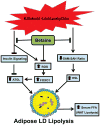Structure, Function and Metabolism of Hepatic and Adipose Tissue Lipid Droplets: Implications in Alcoholic Liver Disease
- PMID: 26278390
- PMCID: PMC4820363
- DOI: 10.2174/1874467208666150817111727
Structure, Function and Metabolism of Hepatic and Adipose Tissue Lipid Droplets: Implications in Alcoholic Liver Disease
Abstract
For more than 30 years, lipid droplets (LDs) were considered as an inert bag of lipid for storage of energy-rich fat molecules. Following a paradigm shift almost a decade ago, LDs are presently considered an active subcellular organelle especially designed for assembling, storing and subsequently supplying lipids for generating energy and membrane synthesis (and in the case of hepatocytes for VLDL secretion). LDs also play a central role in many other cellular functions such as viral assembly and protein degradation. Here, we have explored the structural and functional changes that occur in hepatic and adipose tissue LDs following chronic ethanol consumption in relation to their role in the pathogenesis of alcoholic liver injury.
Keywords: ATGL; HCV; HSL; Liver; MiRs; Src; TGH; VLDL; adipose; alcohol; betaine; dynamin; lipases; lipid; lipid droplet; lipolysis; lipophagy; perilipin; phosphatidylcholine; phosphatidylethanolamine; rab; steatosis; triglycerides.
Copyright© Bentham Science Publishers; For any queries, please email at epub@benthamscience.org.
Figures





References
-
- World Health Organization. [accessed December 4: 2014];Global status report on alcohol and health. http://www.who.int/substance_abuse/publications/global_alcohol_report/ms....
-
- Schiller JS, Lucas JW, Peregoy JA. Summary Health Statistics for U.S. Adults: National Health Interview Survey, 2011. National Center for Health Statistics Vital Health Statistics. 2012;10:1–218. - PubMed
-
- Ishak KG, Zimmerman HJ, Ray MB. Alcoholic liver disease: pathologic, pathogenetic, and clinical aspects. Alcohol Clin Exp Res. 1991;15:45–66. - PubMed
-
- Lieber CS. Alcoholic fatty liver: its pathogenesis and mechanism of progression to inflammation and fibrosis. Alcohol. 2004;34:9–19. - PubMed
-
- Beckman M. Cell biology. Great balls of fat Science. 2006;311:1232–4. - PubMed
Publication types
MeSH terms
Grants and funding
LinkOut - more resources
Full Text Sources
Other Literature Sources
Miscellaneous

